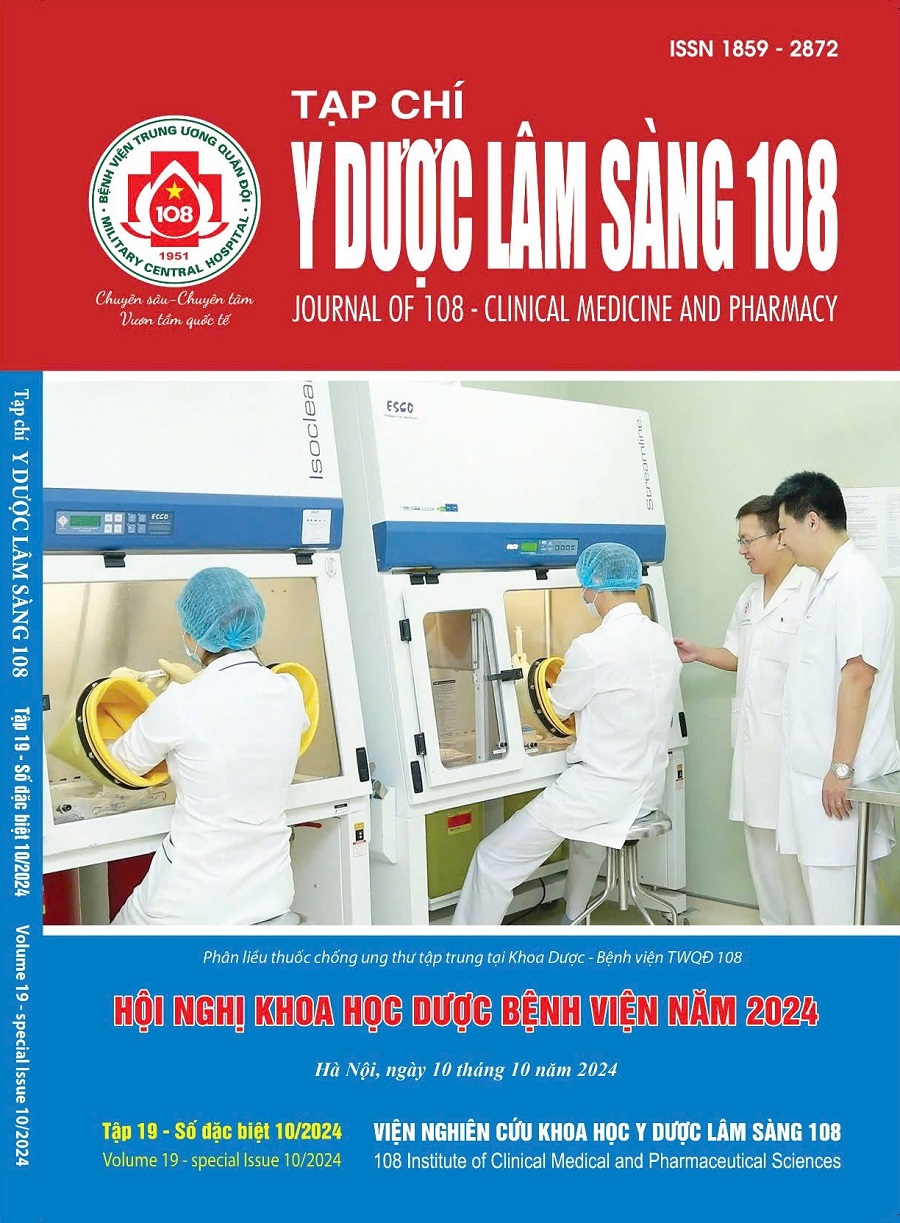Applying population pharmacokinetics in optimizing vancomycin dosing regimens for patients in the surgical intensive care unit at Viet Duc University Hospital
Main Article Content
Keywords
Abstract
Objective: To identify the best-fit population pharmacokinetic (popPK) model for non-neurosurgical patients in the surgical intensive care unit (SICU) and propose optimal initial maintenance doses for each patient’s renal function (ClCr) subgroup. Subject and method: PopPK models identified through a systematic review of the PubMed database were externally validated using data from 45 patients and 58 vancomycin serum concentrations. The model was considered clinically acceptable if it demonstrated a relative bias within ± 30%, a low relative root mean square error, and the best performance in goodness-of-fit plots and prediction-corrected Visual Predictive Checks. Subsequently, we conducted Monte Carlo simulations (n = 1000) using the best-fit model to establish the initial maintenance dose depending on the patient’s renal function. Result: Among the nine validated models, the Thomson model displayed the best predictive performance for patients in the hospital. Simulations indicated that the suggested doses for patients with ClCr < 130 mL/min were consistent with the current dosing regimen recommended at the hospital. Meanwhile, for patients with ClCr > 130 mL/min, the total daily dose may need to be increased to 4500 mg/day. Conclusion: Our study affirmed the appropriateness of the current vancomycin doses applied for most patients, except for those with ClCr > 130 mL/min, a higher dose of up to 4500 mg/day was suggested to achieve therapeutic targets. The Thomson model could be applied into vancomycin dosing adjustments for non-neurosurgical SICU patients at Viet Duc University Hospital.
Article Details
References
2. Bilbao-Meseguer I, Rodriguez-Gascon A, Barrasa H, Isla A, Solinis MA (2018) Augmented renal clearance in critically Ill patients: A systematic review. Clin Pharmacokinet 57(9): 1107-1121. doi:10.1007/s40262-018-0636-7
3. Vu DH, Nguyen DA, Delattre IK et al (2019) Determination of optimal loading and maintenance doses for continuous infusion of vancomycin in critically ill patients: Population pharmacokinetic modelling and simulations for improved dosing schemes. Int J Antimicrob Agents 54(6): 702-708. doi:10.1016/j.ijantimicag.2019.09.018
4. Roberts JA, Lipman J (2099) Pharmacokinetic issues for antibiotics in the critically ill patient. Crit Care Med 37(3): 840-851; quiz 859. doi: 10.1097/CCM.0b013e3181961bff
5. Broeker A, Nardecchia M, Klinker KP et al (2049) Towards precision dosing of vancomycin: A systematic evaluation of pharmacometric models for Bayesian forecasting. Clin Microbiol Infect 25(10): 1286: 1-1286 e7. doi:10.1016/j.cmi.2019.02.029
6. Bang JY, Kang HI, Lee HJ et al (2022) Development of a new pharmacokinetic model for target-concentration controlled infusion of vancomycin in critically ill patients. Clin Exp Pharmacol Physiol 49(2):202-211. doi:10.1111/1440-1681.13597
7. Garreau R, Falquet B, Mioux L et al (2021) Population Pharmacokinetics and Dosing Simulation of Vancomycin Administered by Continuous Injection in Critically Ill Patient. Antibiotics (Basel). Oct 9 10(10). doi:10.3390/antibiotics10101228
8. Kovacevic T, Miljkovic B, Kovacevic P et al (2020) Population pharmacokinetic model of Vancomycin based on therapeutic drug monitoring data in critically ill septic patients. J Crit Care 55:116-121. doi:10.1016/j.jcrc.2019.10.012
9. Medellin-Garibay SE, Romano-Moreno S, Tejedor-Prado P et al (2017) Influence of mechanical ventilation on the pharmacokinetics of vancomycin administered by continuous infusion in critically Ill patients. Antimicrob Agents Chemother. Dec 61(12). doi:10.1128/AAC.01249-17
10. Zhao S, He N, Zhang Y, Wang C, Zhai S, Zhang C (2021) Population Pharmacokinetic Modeling and Dose Optimization of Vancomycin in Chinese Patients with Augmented Renal Clearance. Antibiotics (Basel). Oct 12 10(10). doi:10.3390/antibiotics10101238
11. Goti V, Chaturvedula A, Fossler MJ, Mok S, Jacob JT (2018) (2018) Hospitalized patients with and without hemodialysis have markedly different vancomycin pharmacokinetics: A population pharmacokinetic model-based analysis. Ther Drug Monit 40(2): 212-221. doi:10.1097/FTD.0000000000000490
12. Medellin-Garibay SE, Ortiz-Martin B, Rueda-Naharro A, Garcia B, Romano-Moreno S, Barcia E (2016) Pharmacokinetics of vancomycin and dosing recommendations for trauma patients. J Antimicrob Chemother 71(2): 471-479. doi:10.1093/jac/dkv372
13. Thomson AH, Staatz CE, Tobin CM, Gall M, Lovering AM (2009) Development and evaluation of vancomycin dosage guidelines designed to achieve new target concentrations. J Antimicrob Chemother 63(5):1050-1057. doi:10.1093/jac/dkp085
14. Kim AJ, Lee JY, Choi SA, Shin WG (2016 Comparison of the pharmacokinetics of vancomycin in neurosurgical and non-neurosurgical patients. Int J Antimicrob Agents 48(4): 381-387. doi:10.1016/j.ijantimicag.2016.06.022
15. Wei S, Zhang D, Zhao Z, Mei S (2022) Population pharmacokinetic model of vancomycin in postoperative neurosurgical patients. Front Pharmacol. 13: 1005791. doi: 10.3389/fphar.2022.1005791
16. Narayan SW, Thoma Y, Drennan PG et al (2021) Predictive Performance of Bayesian Vancomycin Monitoring in the Critically Ill. Crit Care Med 49(10): 952-960. doi:10.1097/CCM.0000000000005062
17. Ter Heine R, Keizer RJ, van Steeg K et al (2020) Prospective validation of a model-informed precision dosing tool for vancomycin in intensive care patients. Br J Clin Pharmacol 86(12): 2497-2506. doi:10.1111/bcp.14360
18. Rybak MJ, Le J, Lodise TP et al (2020) Therapeutic monitoring of vancomycin for serious methicillin-resistant Staphylococcus aureus infections: A revised consensus guideline and review by the American Society of Health-System Pharmacists, the Infectious Diseases Society of America, the Pediatric Infectious Diseases Society, and the Society of Infectious Diseases Pharmacists. Am J Health Syst Pharm 77(11):835-864. doi:10.1093/ajhp/zxaa036
19. Tsai D, Stewart PC, Hewagama S et al Optimised dosing of vancomycin in critically ill Indigenous Australian patients with severe sepsis. Anaesth Intensive Care 46(4): 374-380. doi:10.1177/0310057X1804600405
 ISSN: 1859 - 2872
ISSN: 1859 - 2872
